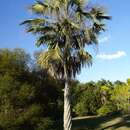en
names in breadcrumbs


The Carnauba Palm (Copernicia prunifera) is native to semi-arid areas of northeastern Brazil, where it is grown extensively on plantations. Its leaves are the source of a heat-resistant wax used in a wide variety of commercial applications from car wax and candy to cosmetics, dental floss, and paper plates.
Lima et al. (2008) studied the role of Carnauba Palm in the ecology of the reduviid bug Rhodnius nasutus, one of several vectors capable of transmitting the pathogen Trypanosoma cruzi, which causes Chagas Disease in humans and currently infects millions of people in Mexico, Central America, and South America. In all locations studied, Carnauba Palms were found to be infested by R. nasutus, a substantial fraction of which were infected with T. cruzi. The authors discuss the risk of R. nasutus adapting to human habitations, as have other reduviid vectors of Chagas Disease.
Whitney (2007) reported that the Fork-tailed Palm-Swift, of tropical South America, builds its nest of feathers and a small amount of plant material and glues it with saliva to the inside of dead, folded pendant leaves of the widespread palm Mauritia flexuosa--or, where this palm is absent in far northeastern Brazil, the leaves of Copernicia prunifera (interestingly, the large number of contour feathers the Palm-Swift uses in its nest are obtained by attacking birds of other species and grabbing off feathers with its bill).